Back to the Mac: how the 14-inch MacBook Pro won over a longtime iPad Pro user
For years, the iPad Pro has been a primary work machine for one AppleInsider employee, but the 14-inch MacBook Pro combined with macOS Monterey has reinvigorated his interest in the Mac.
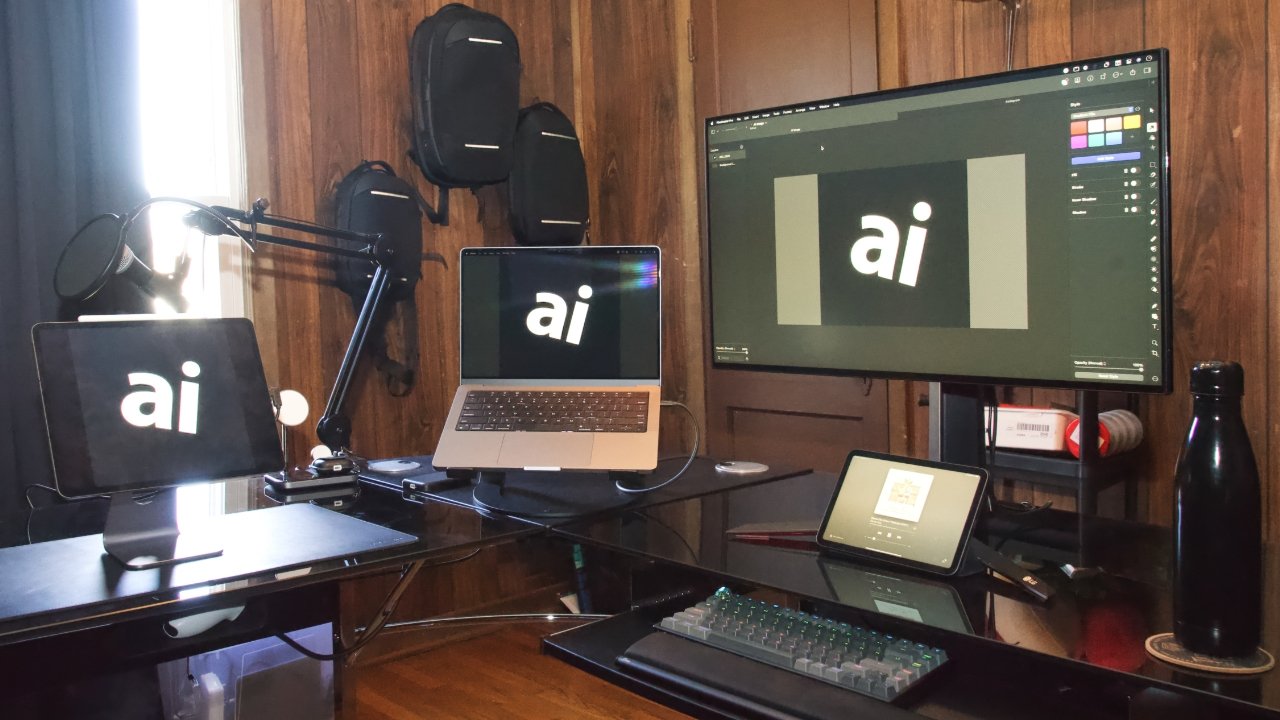
The 14-inch MacBook Pro and iPad Pro work setup
Apple's transition to custom Apple Silicon in its Mac lineup has led to some surprising changes. Several aspects previously reserved for iOS and iPadOS are now front and center in macOS.
Apps can now be truly universal, running similar code bases across all Apple platforms. Combine that with cross-platform features like iCloud, clipboard sharing, and Shortcuts, and the lines begin to blur between what's a Mac feature and an iPhone feature.
Thanks to these elements and many others, the Mac has become attractive again to this iPad fan. While still not perfect, the iOS-ification of macOS has breathed new life into the platform that previously felt derived from somewhere between 1984 and 2006.
There was an acceleration in the iPad's software that began with iOS 9 in 2016. Split View, Slide Over, and Picture-in-Picture changed how the iPad worked and opened the door to true multitasking on those devices.
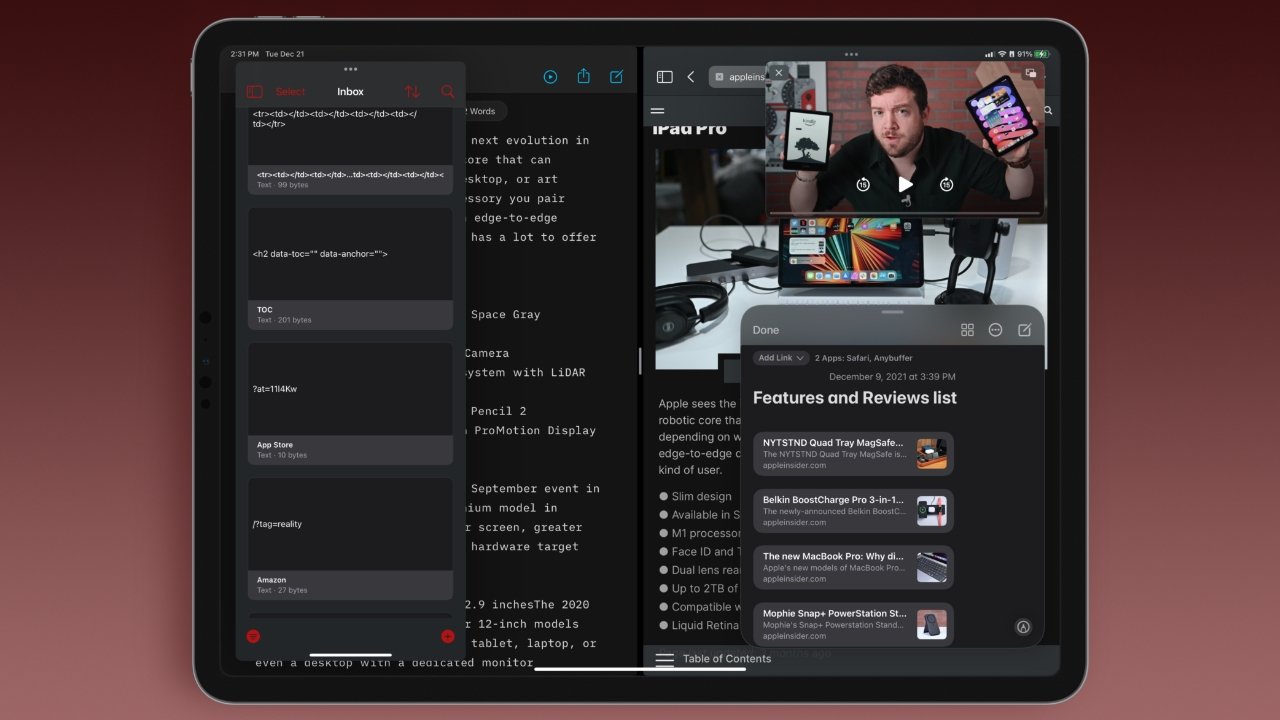
iPadOS multitasking isn't perfect, but power users can get a lot out of it
After Apple announced iOS 10 in 2017, it was clear that feature additions for iPad weren't slowing down. Unfortunately, that year was also when Mac saw a lot of poor press surrounding a lack of hardware updates, no Mac Pro updates, and sticky keyboards.
By the end of 2017, the iPad's software had grown on me. Although at the time, I was still in the Navy and did not rely on my personal computers for work. It's also hard to bring an iMac on a Navy vessel.
However, I found that any task I was routinely performing on my Mac was easily reproduced on the iPad. So, I decided to lean into being an "iPad only" user -- spurred by others doing the same.
From 2017 until 2019, it was a busy time to be an iPad fan. Apple regularly showered the platform with new hardware, and iPadOS grew more independent with each update.

My iPad only setup in 2019
When I was hired on to AppleInsider in December 2019, some were surprised to learn I would be doing the job entirely from an iPad Pro. Note that this was a few months before proper cursor support and new file system changes made working a lot easier.
Now, two years into working solely on a 12.9-inch iPad Pro at AppleInsider recording podcasts, writing articles, and maintaining our knowledge database, I've not felt overburdened by the limitations of the iPadOS platform. But, Apple's push into custom Apple Silicon had repeatedly caught my eye.
No longer did Macs look boring and archaic to me. Sure, the operating system still had the classic desktop, windowing, and mousing paradigms, but Apple had done enough to catch my interest.
With the 14-inch MacBook Pro release, I decided to conduct an experiment. I've spent over a month with the new hardware to re-discover the Mac and determine if it has a place in my workflow.
Rather than break down every spec, I will speak more about how the computers function when used in my day-to-day workflows.
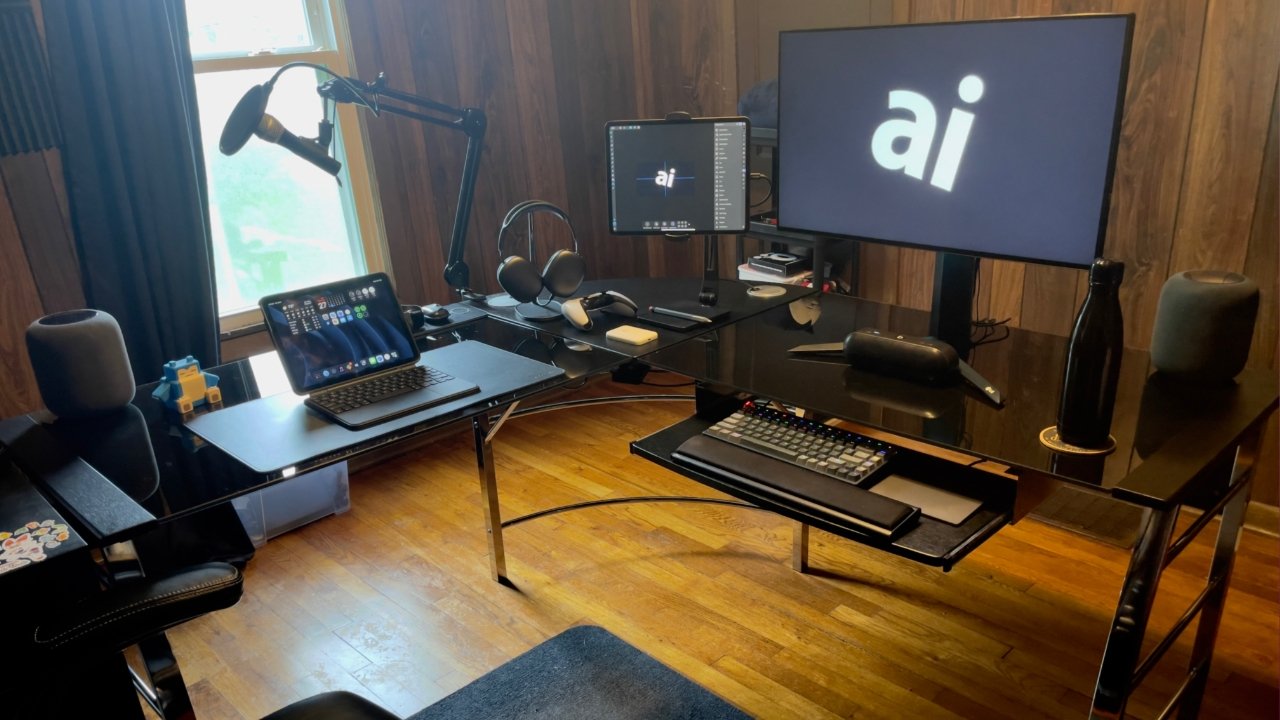
An iPad Pro desk setup using a Thunderbolt hub to connect all the pieces
As an iPad fan, I subscribe to its hardware's "naked robotic core" philosophy. Bring your keyboard, mouse, display, and other accessories and build whatever computer you want with the iPad Pro and M1 processor at its center. The iPad Pro can be used as a tablet, laptop, and desktop machine, depending on what's connected.
The MacBook is a little more set in stone. It has a display attached to a physical keyboard and trackpad, which is great for portable use. However, the port availability means more accessories and combinations are available to the hardware.
While it can't be stripped down to just its display, the MacBook has the advantage of being more useful out of the box without having to purchase additional devices. To me, the iPad represents the future of computing in which a single core device can transform based on its environment, while the MacBook represents the past paradigm of a purpose-built machine.
When testing the 14-inch MacBook Pro, there are certain hardware limitations I've noted when compared to the iPad Pro. For example, I cannot touch the display nor use Apple Pencil directly, the display cannot disconnect, and the lack of Face ID can be frustrating.
However, it is worth noting that macOS wouldn't work well with touch, nor does the angle of the display enable good touch ergonomics. Even when used as a laptop, the iPad Pro is a much better touch experience.
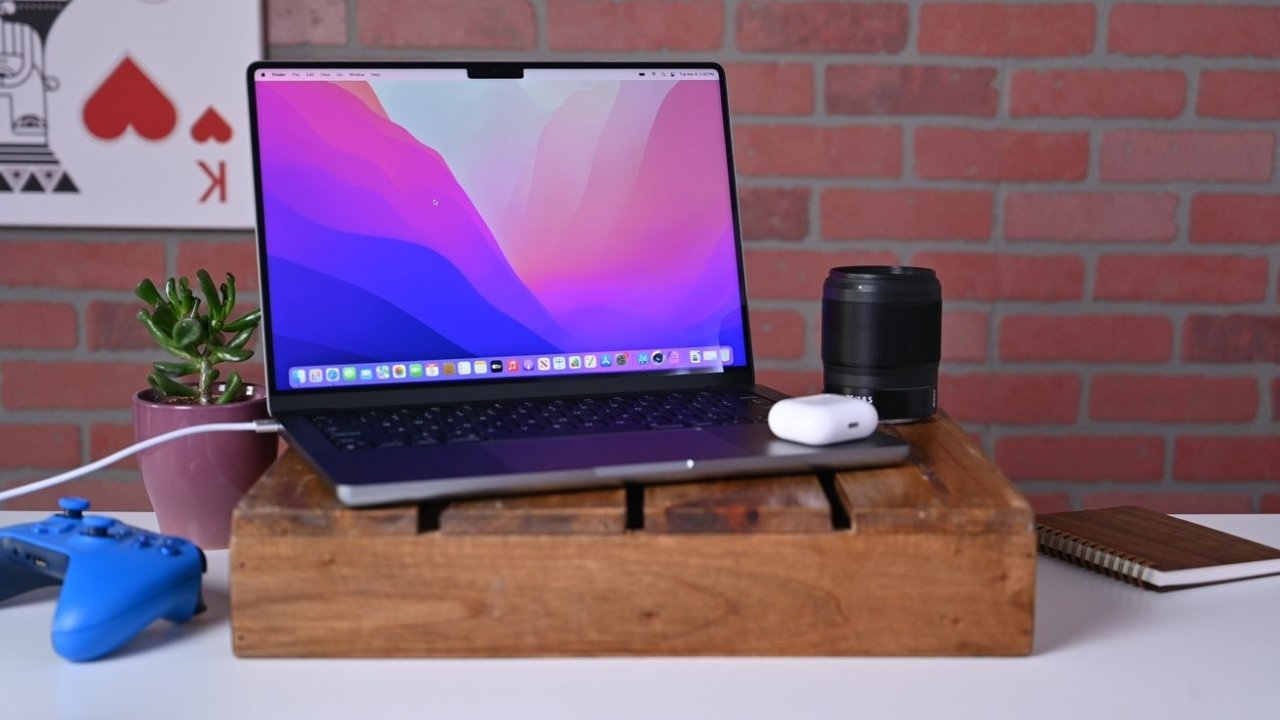
The 14-inch MacBook Pro is a triumph of Apple hardware design
To be sure, the 14-inch MacBook Pro is an outstanding laptop, but I've preferred using it at a desk while connected to a monitor. The display is amazing with its mini-LED backlight and 120Hz refresh rate, but it feels distant, the apps appear smaller, and content looks more spread out across the macOS windowing system.
At a desk, using a large external monitor alleviates these issues. My eyesight isn't terrible, but something about how apps and text are sized in the default resolution of the MacBook Pro display feels smaller when compared to the iPad Pro display.
For me, even with the 14-inch MacBook Pro available, I've preferred taking my iPad Pro when I work away from my desk -- treating the MacBook as a stationary device. Of course, this is for use around the house or during the day. Nevertheless, extended trips would warrant taking the MacBook Pro if only for work-related tasks that I may not have workflows built for on iPad Pro.
This preference is based on how I can interact with the iPad Pro. Not only is the display hovering above the Magic Keyboard when used as a laptop, but it is also tilted up towards my face, not away from me. If I need to bring the display closer to edit an image or manipulate specific content, I can just grab the entire display free of the keyboard and work with the Apple Pencil. Therefore, I view it as a better portable work tool than my MacBook Pro.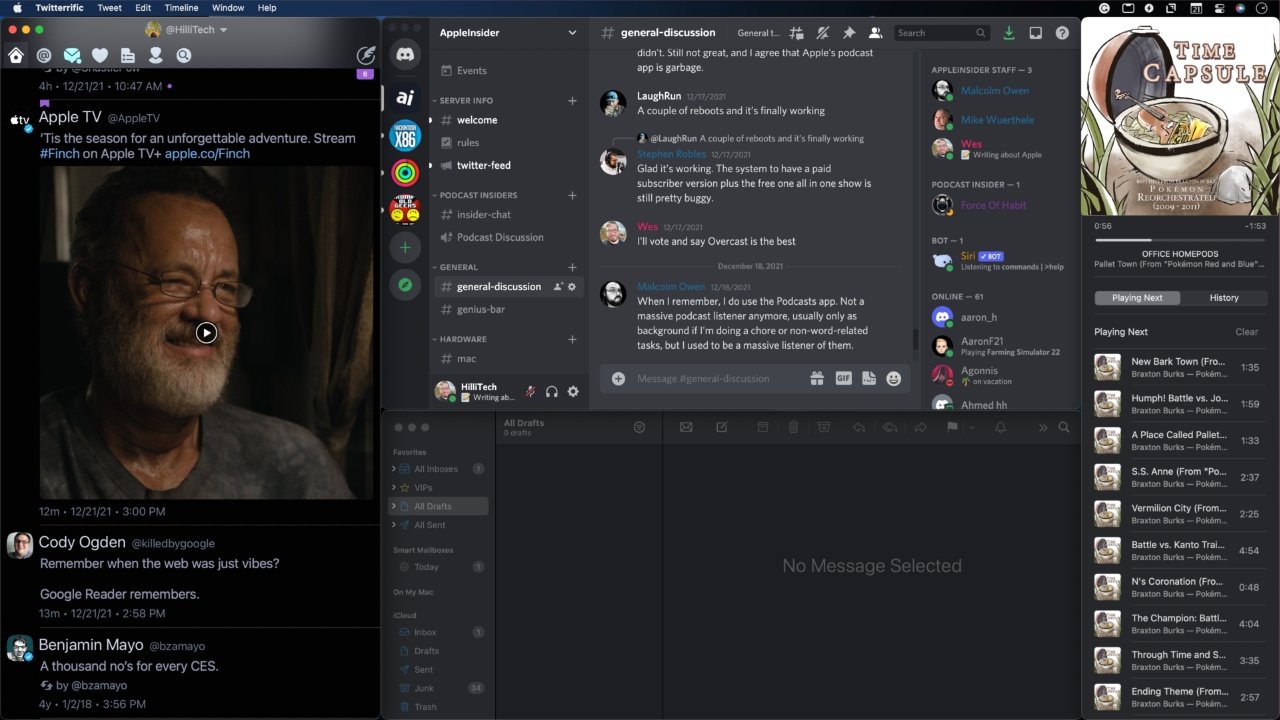
macOS windowing works best when plenty of space is available
Given the display size of both machines, I'd argue that the iPadOS multitasking system is much more optimized for a laptop form factor. In contrast, the macOS multitasking and layered window approach are better on a large desktop monitor.
For example, when using a full-screen app on the Mac, there is no obvious way to incorporate a secondary app into Split View (Yes, I'm aware of App Expose). In addition, the dock doesn't show in full-screen mode, and there's no option for a media window or Slide Over when full screen either. All things macOS could inherit from the iPad.
I'll also argue that a lot of macOS feels old and stale compared to the nearly-whimsical nature of iPadOS. Everything from the Home Screen with widgets to how multitasking operates feels fresh compared to the Mac's empty desktop and windowing paradigm.
By combining Home Screen design with Focus Modes, my iPad Pro can show me the most relevant apps and data at any given time of day. There is no equivalent system for this on the Mac, and the Today View with notifications mixed in isn't a substitute.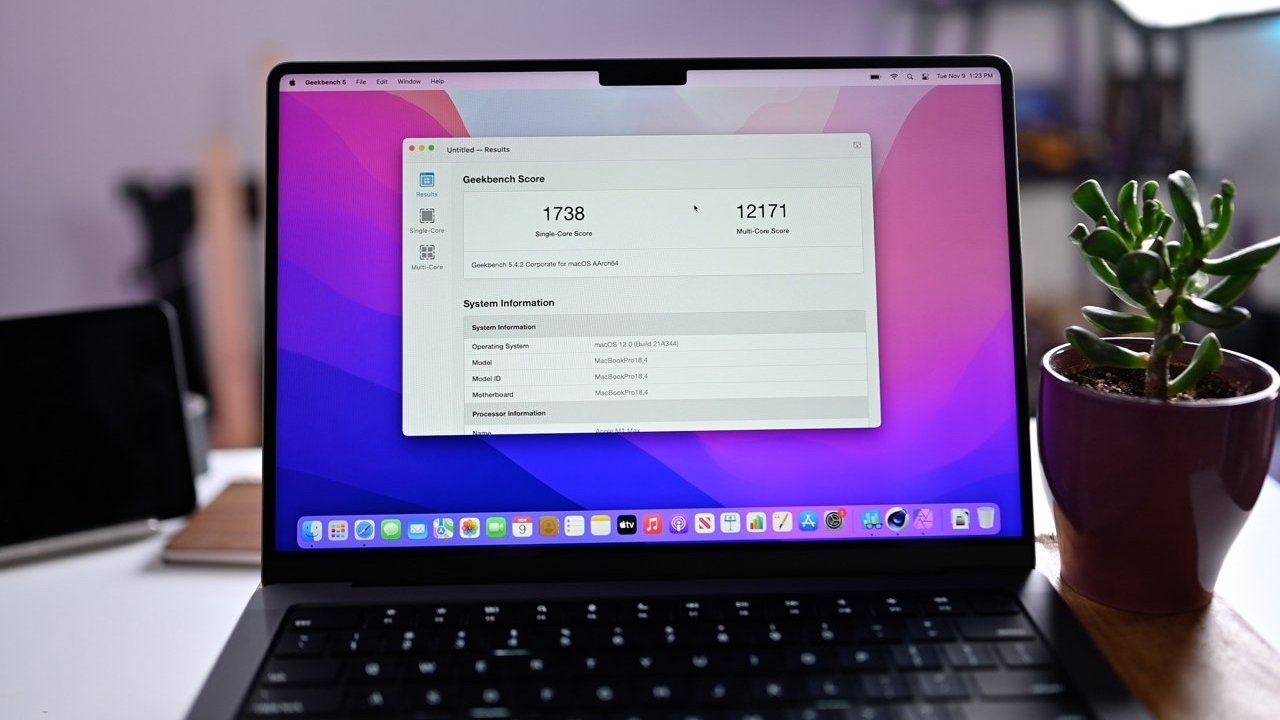
The 14-inch MacBook Pro can outperform most laptops on the market
The M1 Pro will outperform the M1 on every metric, given that it is the more advanced version of the standard processor. Though the M1 is already overpowered for iPadOS, anything more at present wouldn't be utilized properly. So from a sheer power perspective, the MacBook Pro wins hands down.
Thanks to the Media Engine found in the M1 Pro, exporting video content, especially ProRes format, is a fast and seamless process on the MacBook Pro. The iPad Pro can handle large 4K video files recorded in ProRes, so it is handy in a pinch, but for video users, the MacBook Pro is the clear tool of choice if both options are available.
Outside of video and development, the available performance becomes less of a contest given that photo workflows, writing, and other day-to-day tasks likely won't overwhelm either processor or available RAM. This space is where many of my tasks live, giving me plenty of leeways to choose which device to use based on metrics outside of performance alone.
However, the operating systems are very different and have positives and negatives on both sides. While iPadOS is growing more diverse with each update, it is still a locked-down system unable to touch macOS capabilities.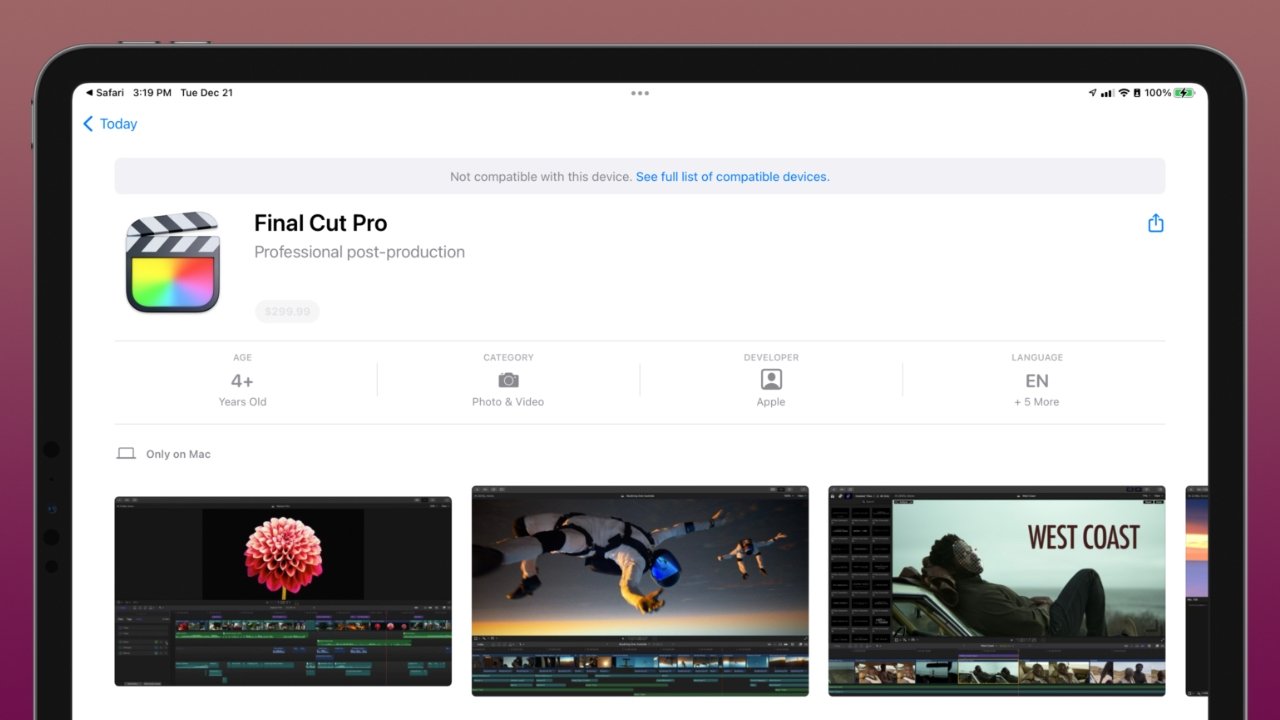
Final Cut Pro won't be available on iPad Pro anytime soon
Theoretically, the iPad Pro with M1 should run any software a MacBook Air with M1 can run, but Apple doesn't want to make the iPad into a Mac or vice versa. As a result, the iPad software library is vast but still locked to what is available in the App Store and only capable of what Apple allows on the platform.
Artificial limitations and oversights from Apple keep the iPad Pro from excelling as a standalone computer. For example, audio intents continue to be broken on the platform despite years of being able to connect multiple audio inputs and outputs to the iPad Pro. Unfortunately, this means we still cannot make a call over Skype and record local audio on the same machine for podcasts.
Other limitations include what apps are allowed to access or control on a system level. There are no clipboard managers, system-wide custom keyboard shortcuts, or control over what is displayed in the status bar. Therefore, iPad Pro can't have popular tools like Keyboard Maestro, Better Touch Tool, or Pastebot, no matter what a developer creates.
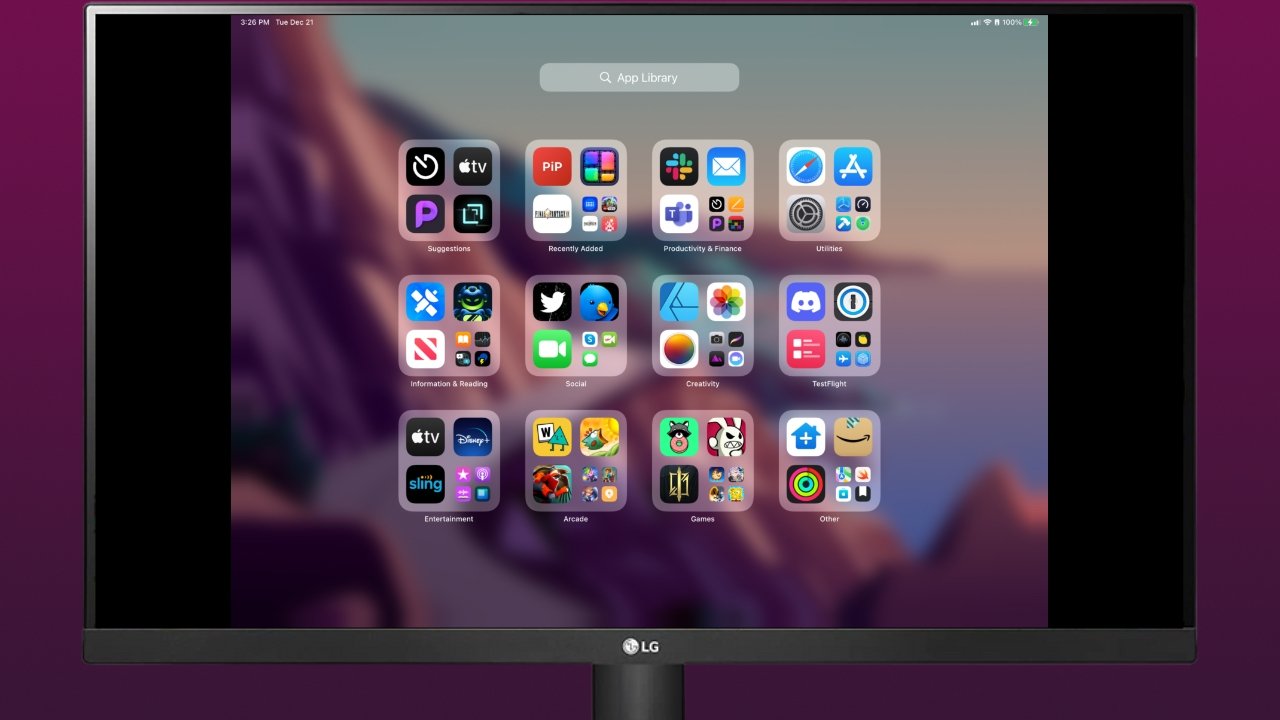
The iPad Pro can only mirror its display to an external monitor
Apple has slowly eliminated hardware and software limitations with each update, however. Over the past few years, iPad users have gained a robust file system, a mouse cursor, external storage support, and multitasking systems. It is expected that even external monitor support will see a significant upgrade soon.
The list of what limits user workflows is growing smaller, but it is doubtful Apple will ever give iPad owners as much control over iPadOS as it does macOS. The Mac started as an open system and has become more closed down with time, but there are always ways to bypass Apple's restrictions on that platform.
These limitations may be enough to deter someone from going iPad-only, but they've never been quite enough to make me jump to the Mac. Even today, my choice to try the 14-inch MacBook Pro has nothing to do with these limitations.
The 14-inch MacBook Pro Magic Keyboard is best in class
As previously mentioned, the Mac is purpose-built as a work machine first with complete user access to every system and tool available in the operating system. This level of control gives users the ability to create complex workflows perfect for their exact needs.
This level of complexity is precisely why people still buy into the old paradigm -- it just works. If you're any level of proficiency with using any computer over the past thirty years, then you'll be able to sit down at a Mac and get work done.
The software available to Mac users is nearly limitless, thanks to applications available directly from the internet. The App Store exists on Mac, but Apple's artificial limitations cause most developers and users to turn to the web.
Connect nearly any peripheral to a Mac, and It'll work, or there's software out there that will make it work. And of course, connecting a Mac to an external monitor, or multiple monitors, is easy and quite useful -- unlike the single mirrored display of the iPad.
What makes the Mac most attractive to people looking to buy a new computer is its lack of limitations. Unless you're trying to run Windows software, you'll be able to perform almost any task available, given you have enough RAM and graphics installed.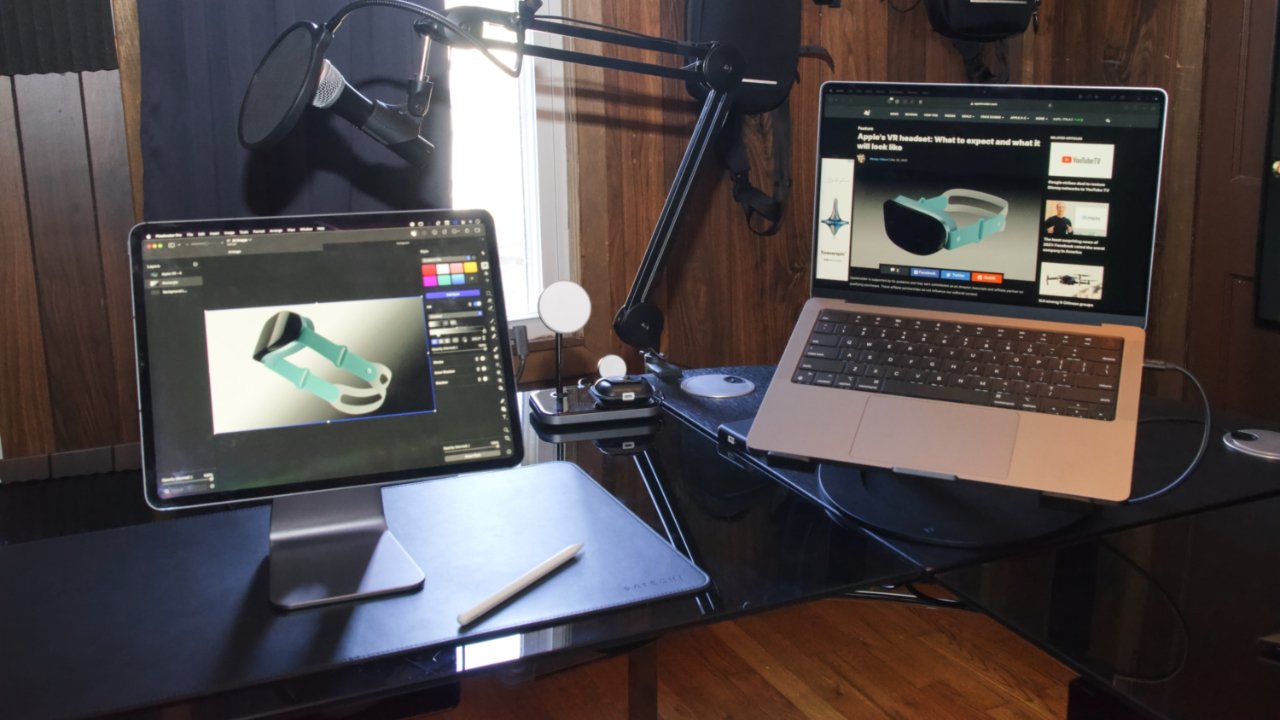
Using SideCar brings Apple Pencil support to Mac apps
Both the iPad Pro and MacBook Pro have things they excel at and workflows unique to them. However, if you can have both products, you'll get the best of both worlds.
What drew me back to the Mac wasn't some specific toolset or processor upgrade -- it was that Apple was finally bringing the Mac entirely in-house. As a result, the hardware and software stack across every computer in Apple's lineup is now completely controlled by Apple.
This means the iPad Pro and MacBook Pro can continue to evolve as distinct devices but gain interoperability that would otherwise be impossible if one were running Intel. Likewise, Macs running iPad apps, Universal Control, and the slow addition of iOS paradigms to macOS are all possible because of the Apple Silicon transition.
Continuity features and cloud computing attracted me to Apple in 2014 in the first place, and it seems Apple is set to redefine continuity again. Soon, the lines will be blurred between devices running Apple software beyond what even SideCar or a universal clipboard could manage.
Over the past few weeks, I've been using the MacBook Pro some days, the iPad Pro others. But, I've been at my most efficient when I have both devices running on my desk in tandem.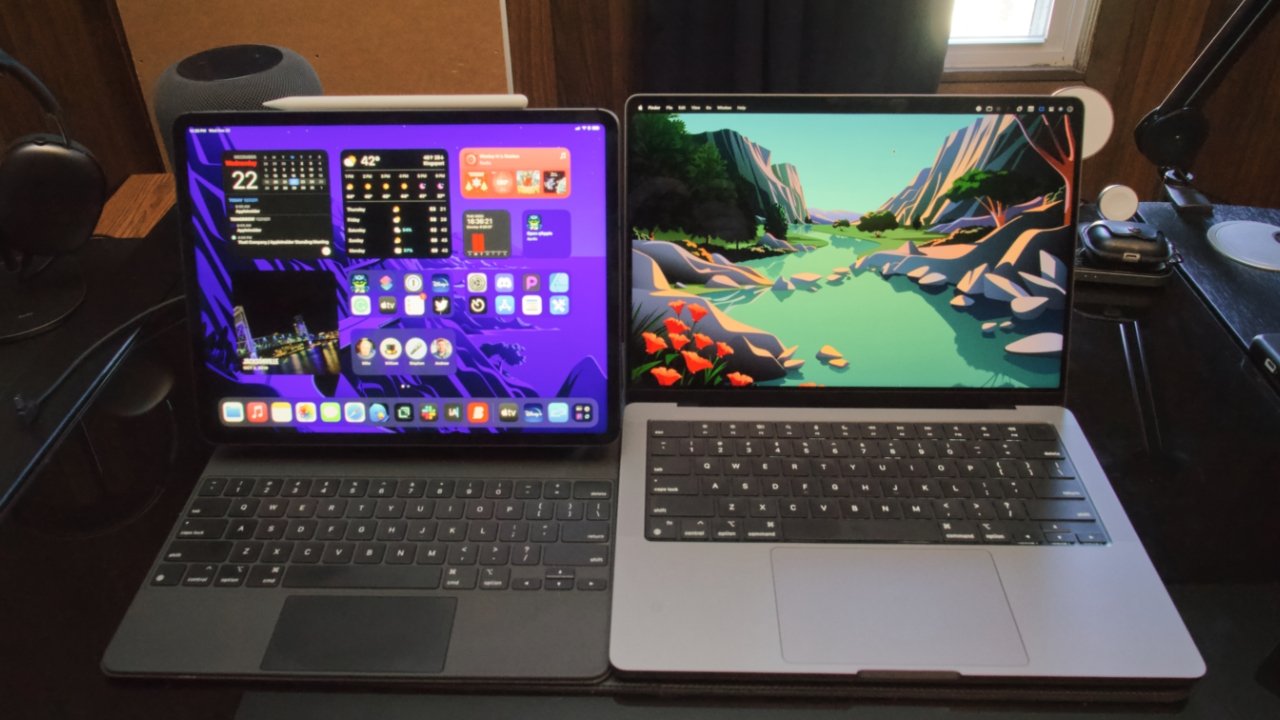
Apple's top-of-the-line portable computers
The experiment is over, and I've decided to keep the 14-inch MacBook Pro in my workflow. However, this isn't a total replacement for the iPad Pro. Both devices will continue to play critical roles in performing my work and personal tasks.
The iPad Pro is still my favorite portable work machine. Whenever I need a break from the office, I grab the iPad Pro and Magic Keyboard. I also prefer using the touch display for image editing and creation in native iPad apps or via SideCar.
The MacBook Pro is the powerhouse and desktop workstation. I can experiment with software that isn't available on the iPad and take more intensive tasks to the M1 Pro as needed. And, since it is still a thin and light laptop, I can disconnect it from the desk for extended trips where I may need to work.
I understand this kind of setup isn't for everyone, but it will be interesting to see how I can take what I've learned from being an iPad-only user and apply it to the Mac. After years of loving the iPad, Apple did what I didn't think was possible -- make me interested in the Mac again.
Read on AppleInsider

The 14-inch MacBook Pro and iPad Pro work setup
Apple's transition to custom Apple Silicon in its Mac lineup has led to some surprising changes. Several aspects previously reserved for iOS and iPadOS are now front and center in macOS.
Apps can now be truly universal, running similar code bases across all Apple platforms. Combine that with cross-platform features like iCloud, clipboard sharing, and Shortcuts, and the lines begin to blur between what's a Mac feature and an iPhone feature.
Thanks to these elements and many others, the Mac has become attractive again to this iPad fan. While still not perfect, the iOS-ification of macOS has breathed new life into the platform that previously felt derived from somewhere between 1984 and 2006.
Why iPad
To preface, I wasn't always an iPad-only user. I've owned several "modern" Macs in my time as an Apple fan. From about 2014 to 2017, I used a 2014 15-inch MacBook Pro, a 2015 27-inch iMac, and the ill-fated 2016 15-inch MacBook Pro.There was an acceleration in the iPad's software that began with iOS 9 in 2016. Split View, Slide Over, and Picture-in-Picture changed how the iPad worked and opened the door to true multitasking on those devices.

iPadOS multitasking isn't perfect, but power users can get a lot out of it
After Apple announced iOS 10 in 2017, it was clear that feature additions for iPad weren't slowing down. Unfortunately, that year was also when Mac saw a lot of poor press surrounding a lack of hardware updates, no Mac Pro updates, and sticky keyboards.
By the end of 2017, the iPad's software had grown on me. Although at the time, I was still in the Navy and did not rely on my personal computers for work. It's also hard to bring an iMac on a Navy vessel.
However, I found that any task I was routinely performing on my Mac was easily reproduced on the iPad. So, I decided to lean into being an "iPad only" user -- spurred by others doing the same.
From 2017 until 2019, it was a busy time to be an iPad fan. Apple regularly showered the platform with new hardware, and iPadOS grew more independent with each update.

My iPad only setup in 2019
When I was hired on to AppleInsider in December 2019, some were surprised to learn I would be doing the job entirely from an iPad Pro. Note that this was a few months before proper cursor support and new file system changes made working a lot easier.
Now, two years into working solely on a 12.9-inch iPad Pro at AppleInsider recording podcasts, writing articles, and maintaining our knowledge database, I've not felt overburdened by the limitations of the iPadOS platform. But, Apple's push into custom Apple Silicon had repeatedly caught my eye.
No longer did Macs look boring and archaic to me. Sure, the operating system still had the classic desktop, windowing, and mousing paradigms, but Apple had done enough to catch my interest.
With the 14-inch MacBook Pro release, I decided to conduct an experiment. I've spent over a month with the new hardware to re-discover the Mac and determine if it has a place in my workflow.
14-inch MacBook Pro versus the 12.9-inch iPad Pro
On paper, the iPad Pro and MacBook Pro don't have a lot of notable hardware differences. However, the operating system, touch display, and port availability are the most significant.| 12.9-inch iPad Pro | 14-inch MacBook Pro | |
| Display | Liquid Retina XDR | Liquid Retina XDR |
| Refresh rate | ProMotion (120Hz) | ProMotion (120Hz) |
| Backlight | mini-LED | mini-LED |
| Ports | Single TB3 port, Smart Connector | TB4 x3, SD, HDMI, MagSafe, headphone jack |
| Keyboard | Software, Magic Keyboard, etc. | Built-in backlit scissor-switch keyboard |
| Interface | Touch, Apple Pencil, mouse, trackpad | Mouse, trackpad |
| Processor | M1 | M1 Pro |
Hardware design

An iPad Pro desk setup using a Thunderbolt hub to connect all the pieces
As an iPad fan, I subscribe to its hardware's "naked robotic core" philosophy. Bring your keyboard, mouse, display, and other accessories and build whatever computer you want with the iPad Pro and M1 processor at its center. The iPad Pro can be used as a tablet, laptop, and desktop machine, depending on what's connected.
The MacBook is a little more set in stone. It has a display attached to a physical keyboard and trackpad, which is great for portable use. However, the port availability means more accessories and combinations are available to the hardware.
While it can't be stripped down to just its display, the MacBook has the advantage of being more useful out of the box without having to purchase additional devices. To me, the iPad represents the future of computing in which a single core device can transform based on its environment, while the MacBook represents the past paradigm of a purpose-built machine.
When testing the 14-inch MacBook Pro, there are certain hardware limitations I've noted when compared to the iPad Pro. For example, I cannot touch the display nor use Apple Pencil directly, the display cannot disconnect, and the lack of Face ID can be frustrating.
However, it is worth noting that macOS wouldn't work well with touch, nor does the angle of the display enable good touch ergonomics. Even when used as a laptop, the iPad Pro is a much better touch experience.

The 14-inch MacBook Pro is a triumph of Apple hardware design
To be sure, the 14-inch MacBook Pro is an outstanding laptop, but I've preferred using it at a desk while connected to a monitor. The display is amazing with its mini-LED backlight and 120Hz refresh rate, but it feels distant, the apps appear smaller, and content looks more spread out across the macOS windowing system.
At a desk, using a large external monitor alleviates these issues. My eyesight isn't terrible, but something about how apps and text are sized in the default resolution of the MacBook Pro display feels smaller when compared to the iPad Pro display.
For me, even with the 14-inch MacBook Pro available, I've preferred taking my iPad Pro when I work away from my desk -- treating the MacBook as a stationary device. Of course, this is for use around the house or during the day. Nevertheless, extended trips would warrant taking the MacBook Pro if only for work-related tasks that I may not have workflows built for on iPad Pro.
This preference is based on how I can interact with the iPad Pro. Not only is the display hovering above the Magic Keyboard when used as a laptop, but it is also tilted up towards my face, not away from me. If I need to bring the display closer to edit an image or manipulate specific content, I can just grab the entire display free of the keyboard and work with the Apple Pencil. Therefore, I view it as a better portable work tool than my MacBook Pro.
Software

macOS windowing works best when plenty of space is available
Given the display size of both machines, I'd argue that the iPadOS multitasking system is much more optimized for a laptop form factor. In contrast, the macOS multitasking and layered window approach are better on a large desktop monitor.
For example, when using a full-screen app on the Mac, there is no obvious way to incorporate a secondary app into Split View (Yes, I'm aware of App Expose). In addition, the dock doesn't show in full-screen mode, and there's no option for a media window or Slide Over when full screen either. All things macOS could inherit from the iPad.
I'll also argue that a lot of macOS feels old and stale compared to the nearly-whimsical nature of iPadOS. Everything from the Home Screen with widgets to how multitasking operates feels fresh compared to the Mac's empty desktop and windowing paradigm.
By combining Home Screen design with Focus Modes, my iPad Pro can show me the most relevant apps and data at any given time of day. There is no equivalent system for this on the Mac, and the Today View with notifications mixed in isn't a substitute.
Performance

The 14-inch MacBook Pro can outperform most laptops on the market
The M1 Pro will outperform the M1 on every metric, given that it is the more advanced version of the standard processor. Though the M1 is already overpowered for iPadOS, anything more at present wouldn't be utilized properly. So from a sheer power perspective, the MacBook Pro wins hands down.
Thanks to the Media Engine found in the M1 Pro, exporting video content, especially ProRes format, is a fast and seamless process on the MacBook Pro. The iPad Pro can handle large 4K video files recorded in ProRes, so it is handy in a pinch, but for video users, the MacBook Pro is the clear tool of choice if both options are available.
Outside of video and development, the available performance becomes less of a contest given that photo workflows, writing, and other day-to-day tasks likely won't overwhelm either processor or available RAM. This space is where many of my tasks live, giving me plenty of leeways to choose which device to use based on metrics outside of performance alone.
However, the operating systems are very different and have positives and negatives on both sides. While iPadOS is growing more diverse with each update, it is still a locked-down system unable to touch macOS capabilities.
Where iPad Pro falls short

Final Cut Pro won't be available on iPad Pro anytime soon
Theoretically, the iPad Pro with M1 should run any software a MacBook Air with M1 can run, but Apple doesn't want to make the iPad into a Mac or vice versa. As a result, the iPad software library is vast but still locked to what is available in the App Store and only capable of what Apple allows on the platform.
Artificial limitations and oversights from Apple keep the iPad Pro from excelling as a standalone computer. For example, audio intents continue to be broken on the platform despite years of being able to connect multiple audio inputs and outputs to the iPad Pro. Unfortunately, this means we still cannot make a call over Skype and record local audio on the same machine for podcasts.
Other limitations include what apps are allowed to access or control on a system level. There are no clipboard managers, system-wide custom keyboard shortcuts, or control over what is displayed in the status bar. Therefore, iPad Pro can't have popular tools like Keyboard Maestro, Better Touch Tool, or Pastebot, no matter what a developer creates.

The iPad Pro can only mirror its display to an external monitor
Apple has slowly eliminated hardware and software limitations with each update, however. Over the past few years, iPad users have gained a robust file system, a mouse cursor, external storage support, and multitasking systems. It is expected that even external monitor support will see a significant upgrade soon.
The list of what limits user workflows is growing smaller, but it is doubtful Apple will ever give iPad owners as much control over iPadOS as it does macOS. The Mac started as an open system and has become more closed down with time, but there are always ways to bypass Apple's restrictions on that platform.
These limitations may be enough to deter someone from going iPad-only, but they've never been quite enough to make me jump to the Mac. Even today, my choice to try the 14-inch MacBook Pro has nothing to do with these limitations.
Where the Mac excels

The 14-inch MacBook Pro Magic Keyboard is best in class
As previously mentioned, the Mac is purpose-built as a work machine first with complete user access to every system and tool available in the operating system. This level of control gives users the ability to create complex workflows perfect for their exact needs.
This level of complexity is precisely why people still buy into the old paradigm -- it just works. If you're any level of proficiency with using any computer over the past thirty years, then you'll be able to sit down at a Mac and get work done.
The software available to Mac users is nearly limitless, thanks to applications available directly from the internet. The App Store exists on Mac, but Apple's artificial limitations cause most developers and users to turn to the web.
Connect nearly any peripheral to a Mac, and It'll work, or there's software out there that will make it work. And of course, connecting a Mac to an external monitor, or multiple monitors, is easy and quite useful -- unlike the single mirrored display of the iPad.
What makes the Mac most attractive to people looking to buy a new computer is its lack of limitations. Unless you're trying to run Windows software, you'll be able to perform almost any task available, given you have enough RAM and graphics installed.
A hybrid approach

Using SideCar brings Apple Pencil support to Mac apps
Both the iPad Pro and MacBook Pro have things they excel at and workflows unique to them. However, if you can have both products, you'll get the best of both worlds.
What drew me back to the Mac wasn't some specific toolset or processor upgrade -- it was that Apple was finally bringing the Mac entirely in-house. As a result, the hardware and software stack across every computer in Apple's lineup is now completely controlled by Apple.
This means the iPad Pro and MacBook Pro can continue to evolve as distinct devices but gain interoperability that would otherwise be impossible if one were running Intel. Likewise, Macs running iPad apps, Universal Control, and the slow addition of iOS paradigms to macOS are all possible because of the Apple Silicon transition.
Continuity features and cloud computing attracted me to Apple in 2014 in the first place, and it seems Apple is set to redefine continuity again. Soon, the lines will be blurred between devices running Apple software beyond what even SideCar or a universal clipboard could manage.
Over the past few weeks, I've been using the MacBook Pro some days, the iPad Pro others. But, I've been at my most efficient when I have both devices running on my desk in tandem.
Expansion, not replacement

Apple's top-of-the-line portable computers
The experiment is over, and I've decided to keep the 14-inch MacBook Pro in my workflow. However, this isn't a total replacement for the iPad Pro. Both devices will continue to play critical roles in performing my work and personal tasks.
The iPad Pro is still my favorite portable work machine. Whenever I need a break from the office, I grab the iPad Pro and Magic Keyboard. I also prefer using the touch display for image editing and creation in native iPad apps or via SideCar.
The MacBook Pro is the powerhouse and desktop workstation. I can experiment with software that isn't available on the iPad and take more intensive tasks to the M1 Pro as needed. And, since it is still a thin and light laptop, I can disconnect it from the desk for extended trips where I may need to work.
I understand this kind of setup isn't for everyone, but it will be interesting to see how I can take what I've learned from being an iPad-only user and apply it to the Mac. After years of loving the iPad, Apple did what I didn't think was possible -- make me interested in the Mac again.
Read on AppleInsider


Comments
Split screens on the Mac are not quite as intuitive as they are on the iPad, but they're not bad and readily available, and the dock appears as soon as you bring the cursor down to the bottom of the screen - I'm not sure how you can cite that as a limitation of the Mac.
Ultimately, I'm happy with the progress that Apple has made with iPadOS but it's been frustratingly slow and continues to hamstring an incredibly powerful device.
macOS needs to:
1) Transition to an App Store only distribution model, the current hybrid is an archaic, random mess. Has anyone thought why free apps aren’t on the App Store (hint: Trojan)
2) Lose the old local user in favour of an AppleIDs
3) Get Split View closer to iPad and support 3 tiled app windows for larger external displays + better mission control for external displays. NOT copy Windows' janky side-by-side view.
iPadOS needs to:
1) Sort out local storage management by offloading app docs & data to an automatic iCloud mirror (currently you can offload the app itself only).
2) Replace the regular hierarchical filesystem with a system-wide information tagging model accessible across apps.
3) Improve external monitor support aligned with macOS.
and no McDave, offloading files to an iCloud server would end the use of the iPad in many workplaces where iCloud is not allowed in the profile. Ditto the removal of hierarchical file system. The iPad has to be able to read them, as the real world uses them.
The notion of “Apple exclusive aggregate features,” those that exist only when multiple Apple products are used together is rather intriguing. Universal control is a good example of this as is sign-on with Apple Watch. I’d like to see more sensor data fusion between Apple devices including Apple Watch, iPhone, Apple TV, and even Apple Pencil, e.g., being able use Apple Pencil to write on a version of the Magic Trackpad.
One potential mega feature related to iPad Pro and Mac that would exploit the common HW/SW stack would be to allow an iPad Pro to boot into macOS when a keyboard and mouse is plugged into the iPad Pro, i.e., iPad Pro BootCamp. This seems a little Neanderthal to me, but somebody might want to do it with a sufficiently beefy iPad Pro.
These aren't the best thing to interfere with but are perfectly efficient. Not saying it's the way for personal computers, but they have their use cases.
• All you need is an external keyboard, Bluetooth or Smart connected.
• Why on earth don’t you have a physical keyboard for your iPad Pro? On-screen keyboards are hard to use by comparison
• Once you have one, you can also easily do things like ©, ®, £ and so forth
• While you’re at it, get a trackpad for it as well, It’s a huge bonus and keeps the screen clean!
I would like to hear more about this!
Hope he kept hold of that machine, it’d be worth a lot of money considering Apple never released a 16” MacBook Pro in 2016. Must’ve been a model that escaped the lab.
https://support.apple.com/kb/SP749
??